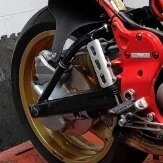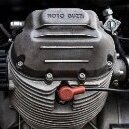
dlaing
Members-
Posts
7,096 -
Joined
-
Last visited
Profile Information
-
Location
California
-
My bike(s)
2000 V11Sport
Recent Profile Visitors
2,420 profile views
dlaing's Achievements

"I live here" (5/5)
5
Reputation
-
Anyone Interested In Ordering Mike Rich Pistons With Me?
dlaing replied to Mike Stewart's topic in Technical Topics
Never mind, just read the price on the first page... -
Anyone Interested In Ordering Mike Rich Pistons With Me?
dlaing replied to Mike Stewart's topic in Technical Topics
Wow! I visit for the first time in forever and the first topic I read has my name in it. Anyway, I am still dreaming of the pistons, too. Any idea what the price is with rings, pin, etc.? -
if wheel bearings are getting notchy, most likely caused by too short of bearing spacer. result is that when axle is tightened, bearing is under pressure that it is not designed to withstand. search forum for proper measurement info. please take this issue seriously. failing to remedy could result in bearing seizure and wheel lockup. this should have been a safety recall. IMHO
-
OK one hour of searching later, here is Greg's post, indicating half a degree of rake difference. http://www.v11lemans.com/forums/index.php?showtopic=15075&st=135&p=163761entry163761
-
Greg Field posted something about angle being offset in the triple clamps on the black frames. but I can't find the post.
-
The ride height will be higher than stock, but it can of course be lowered by decreasing preload to increase sag. It is all a balancing act of factors: Correct ride height, Correct laden sag, Correct unladen sag, Correct spring rate, AND it all should balance with the front, but keep in mind the front is much more progressive, so perfection is always a compromise. Chances are they gave you a much firmer spring than OEM, so you should be able to increase unladen sag greater than the OEM shock. But you may like the higher rear height as it does make the bike more nimble. My Penske manual recommended 7/8" - 1-1/16" laden sag. I set it to 5.5mm unladen and 31.3mm laden which is a little more than they recommend, and I do get some occasional bottoming out. I have 550# spring and I weigh 225-240 lbs with gear. I'd ideally like to switch to a 600# spring or a HyperPro rising rate spring...I think...but I am not sure, so I'll save my money for gas. In any case you should find it is so much better than the OEM Sachs was, especially if you are heavy rider.
-
Carl Allison's schematics have corrections and color that the owner and workshop manuals do not have. Carl went through several revisions based on discovered errors in the OEM manual's schematics.
-
From my website: front bearings as accurately as we have discerned, the combination of a 6304 and 6205 appears on bikes with a solid axle. Bikes with a hollow axle have a pair of 6205 bearings. 6304 is 20 x 52 x 15 mm 92 20 52 27 which may cross ref 92 20 14 20 from older Guzzi. 6205 is 25 x 52 x 15 mm 92 20 18 21 http://webspace.webring.com/people/ur/rcdlaing/
-
obviously you didn't argue hard enough or maybe you need to better relate dude lol Just kidding for pete's sake! more than what you need to know is in this thread: http://www.v11lemans.com/forums/index.php?showtopic=1097&hl= short answer 12mm
-
The Penske reservoir does not use the stock holder. It comes with rubber blocks to mount it to the starter. Orienting the hose is a little tricky but doable. They cut it to the perfect length without me specifying. I did have trouble getting the right size bushing spacers from them, but they were great at FedExing the correct ones, but mine was custom ordered to be as close to Ohlins dimensions as possible, so they used different parts which may have triggered the wrong size bushings getting delivered. There support is excellent, so if there is a problem with the length or anything, they will be there for you. I felt treated like a pro racer in race season!!!
-
I put my wide band O2 sensor where Paul put his. With the wide band sensors it is important to get it in the right area. I'd avoid putting it in the crossover. Are the widebands more accurate for closed loop on the my15?
-
legally a promise by word is still a contract. Credibility of the accusation of course won't carry as much weight, but then they would have to lie under oath. So, not only did they bill for $70 per hour, they charged 1000/25= 40 hours labor to do that little work?!? Or was it 1000/70=14 hours sounds more like it. Did they estimate time? I am slow as molasses, and I could do all but the paint stripping in about 6 hours Stripping the paint might take a couple days of soaking, but labor should only be a couple hours, I'd guess, but maybe the paint on our wheels is extra tough????? Powdercoating wheels should be less than $200 for the pair, but I am assuming that was an additional cost billed by another company. Good grief! take them to court! Oooops, I just read your edited post, where you changed the price difference from 1000 to 800, so that would be 32 hours iabor!!!!!!! Is an oil change there 5 hours labor????
-
Once the 150mV baseline is correct, its just a case of balancing AND getting idle speed correct AND TPS reading correct AND CO reading correct. Correct TPS reading, and Veglia idle speed vary by bike. According to documentation at http://www.mphcycles.com/Technical/tpsexcel3.htm the ECU recognizes anything below 575mV to be at idle, as seen by flag on diagnostic program. The ECU never sees the 150mV during normal operation. The 150 mV is measured when throttle linkage is disconnected. When throttle linkage is connected the TPS will be about 500mV (give or take about 75mV) and should be what the ECU sees at idle. Theoretically if you disconnect the linkage and set screws and move the right TB valve from fully closed to fully open the voltage should go from 150mV when fully closed to just under 5V at WOT (wide open throttle) (4.85V might be a typical reading, but it should probably be between 4.75 and 4.95V) A few on the forum could not get the engine to run right when using the 150mV setting. Instead they used a recommended mV at idle and got good results. Either way should work if done correctly. Also, I find that at 1300 RPM the transmission clunks when shifting from neutral to first. If yours shifts smoothly than you are probably fine at that RPM reading. In any case you want to keep idle RPMs well above the stalling point, but below the transmission clunking point and below 575mV (4 degrees as read by diagnostic software) The speedometers on our bikes are not all calibrated the same. Being off by 200 rpms or more seems to be common.
-
The simple solution is to turn both idle set screws out the same exact number of turns. Whatever you do, count the precise number of turns so you can undo what you did. You probably only need to go about a quarter turn out. But I recommend you should check the balance and check the TPS reading. Buying something to measure balance is not that expensive and once you have it, it is very quick and easy to check the balance....but setting it can take more effort. I also recommend splicing in connectors to read the TPS (but this could invalidate your warranty)
-
The more you pound a point to death, the less everyone else listens. The more you pound a point to death, the less everyone else listens. The more you pound a point to death, the less everyone else listens. The more you pound a point to death, the less everyone else listens. The more you pound a point to death, the less everyone else listens. The more you pound a point to death, the less everyone else listens. The more you pound a point to death, the less everyone else listens. The more you pound a point to death, the less everyone else listens. The more you pound a point to death, the less everyone else listens. The more you pound a point to death, the less everyone else listens. The more you pound a point to death, the less everyone else listens. The more you pound a point to death, the less everyone else listens. The more you pound a point to death, the less everyone else listens. The more you pound a point to death, the less everyone else listens. The more you pound a point to death, the less everyone else listens. The more you pound a point to death, the less everyone else listens. The more you pound a point to death, the less everyone else listens. The more you pound a point to death, the less everyone else listens. The more you pound a point to death, the less everyone else listens. The more you pound a point to death, the less everyone else listens. The more you pound a point to death, the less everyone else listens. The more you pound a point to death, the less everyone else listens. The more you pound a point to death, the less everyone else listens. The more you pound a point to death, the less everyone else listens. The more you pound a point to death, the less everyone else listens. The more you pound a point to death, the less everyone else listens. The more you pound a point to death, the less everyone else listens. The more you pound a point to death, the less everyone else listens. The more you pound a point to death, the less everyone else listens. The more you pound a point to death, the less everyone else listens. The more you pound a point to death, the less everyone else listens. The more you pound a point to death, the less everyone else listens. The more you pound a point to death, the less everyone else listens. The more you pound a point to death, the less everyone else listens. The more you pound a point to death, the less everyone else listens. The more you pound a point to death, the less everyone else listens. The more you pound a point to death, the less everyone else listens. The more you pound a point to death, the less everyone else listens. The more you pound a point to death, the less everyone else listens. The more you pound a point to death, the less everyone else listens. The more you pound a point to death, the less everyone else listens. The more you pound a point to death, the less everyone else listens. The more you pound a point to death, the less everyone else listens. The more you pound a point to death, the less everyone else listens. The more you pound a point to death, the less everyone else listens. The more you pound a point to death, the less everyone else listens. The more you pound a point to death, the less everyone else listens. The more you pound a point to death, the less everyone else listens. The more you pound a point to death, the less everyone else listens. The more you pound a point to death, the less everyone else listens. The more you pound a point to death, the less everyone else listens. The more you pound a point to death, the less everyone else listens. The more you pound a point to death, the less everyone else listens. The more you pound a point to death, the less everyone else listens. The more you pound a point to death, the less everyone else listens. The more you pound a point to death, the less everyone else listens. The more you pound a point to death, the less everyone else listens. The more you pound a point to death, the less everyone else listens. The more you pound a point to death, the less everyone else listens. The more you pound a point to death, the less everyone else listens. The more you pound a point to death, the less everyone else listens. The more you pound a point to death, the less everyone else listens. The more you pound a point to death, the less everyone else listens. The more you pound a point to death, the less everyone else listens. The more you pound a point to death, the less everyone else listens. The more you pound a point to death, the less everyone else listens. The more you pound a point to death, the less everyone else listens. The more you pound a point to death, the less everyone else listens. The more you pound a point to death, the less everyone else listens. The more you pound a point to death, the less everyone else listens. The more you pound a point to death, the less everyone else listens. The more you pound a point to death, the less everyone else listens. The more you pound a point to death, the less everyone else listens. The more you pound a point to death, the less everyone else listens. The more you pound a point to death, the less everyone else listens. The more you pound a point to death, the less everyone else listens. The more you pound a point to death, the less everyone else listens. The more you pound a point to death, the less everyone else listens. The more you pound a point to death, the less everyone else listens. The more you pound a point to death, the less everyone else listens. The more you pound a point to death, the less everyone else listens. The more you pound a point to death, the less everyone else listens. The more you pound a point to death, the less everyone else listens. The more you pound a point to death, the less everyone else listens. The more you pound a point to death, the less everyone else listens. The more you pound a point to death, the less everyone else listens. The more you pound a point to death, the less everyone else listens. The more you pound a point to death, the less everyone else listens. The more you pound a point to death, the less everyone else listens. The more you pound a point to death, the less everyone else listens. The more you pound a point to death, the less everyone else listens. The more you pound a point to death, the less everyone else listens. The more you pound a point to death, the less everyone else listens. The more you pound a point to death, the less everyone else listens. The more you pound a point to death, the less everyone else listens. The more you pound a point to death, the less everyone else listens. The more you pound a point to death, the less everyone else listens. The more you pound a point to death, the less everyone else listens. The more you pound a point to death, the less everyone else listens. The more you pound a point to death, the less everyone else listens. The more you pound a point to death, the less everyone else listens. The more you pound a point to death, the less everyone else listens. The more you pound a point to death, the less everyone else listens. The more you pound a point to death, the less everyone else listens. The more you pound a point to death, the less everyone else listens. The more you pound a point to death, the less everyone else listens. The more you pound a point to death, the less everyone else listens. The more you pound a point to death, the less everyone else listens. The more you pound a point to death, the less everyone else listens. The more you pound a point to death, the less everyone else listens. The more you pound a point to death, the less everyone else listens.







